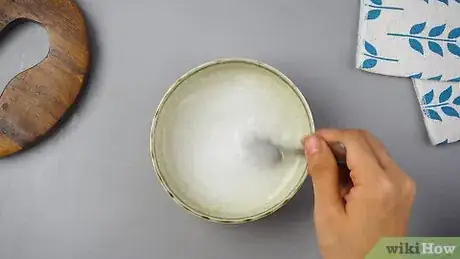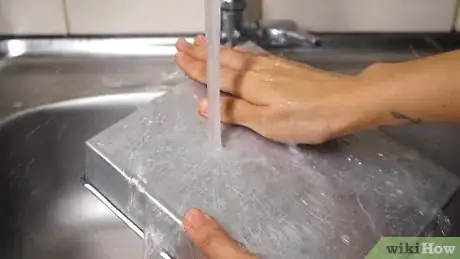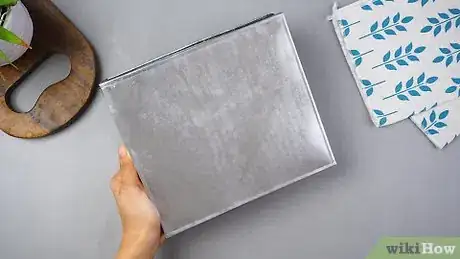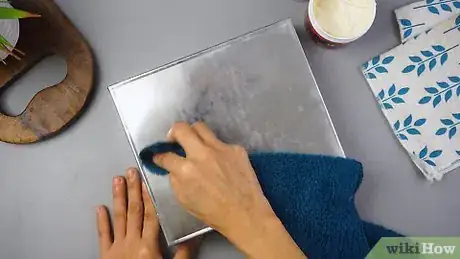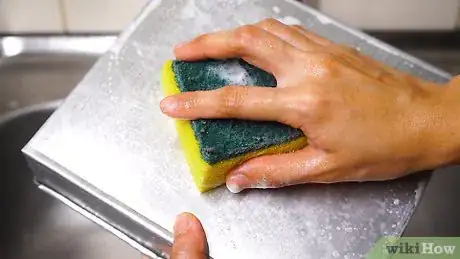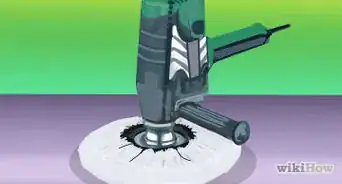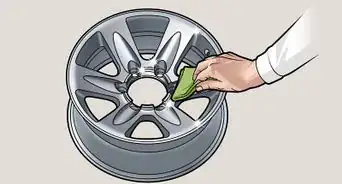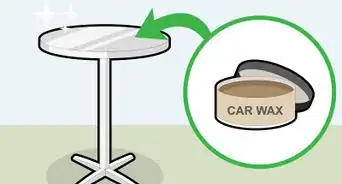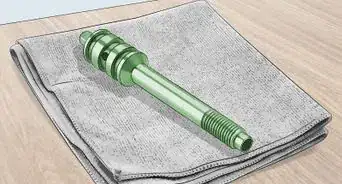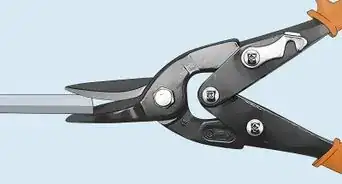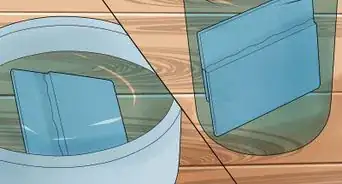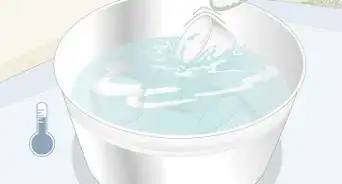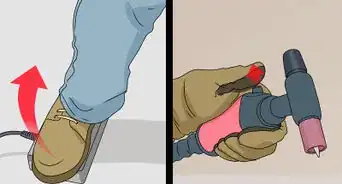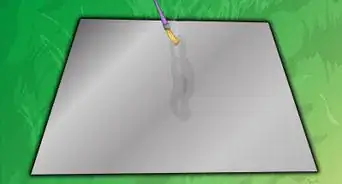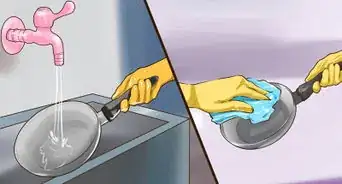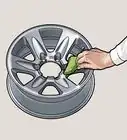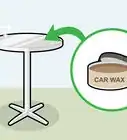This article was co-authored by Cleanzen Cleaning Services and by wikiHow staff writer, Sophia Latorre. The Cleanzen Cleaning Services Team consists of Residential Cleaning Specialists. With more than six years of experience, they specialize in connecting independent cleaning professionals with those who need help cleaning their houses. All of Cleanzen’s professionals are experienced and licensed and have passed background checks.
This article has been viewed 500,527 times.
Aluminum, like many other metals, can become tarnished because of oxidation when not in use. For small items, like pots and pans, first clean the item with soap and water, then apply an aluminum polish or a paste made from cream of tartar. For sheet metal, start with a clean, dry piece. Sand the sheet metal, then apply a cutting compound and use a rotating buffing tool to polish the piece.
Steps
Using Cream of Tartar
-
1Mix cream of tartar with water. Cream of tartar, also known as potassium bitartrate, is a byproduct of wine-making and has many household applications as a cleaner.[1] Mix together equal parts cream of tartar and warm water to form a paste.
-
2Apply the product to the aluminum. Work the cream of tartar onto the aluminum using a soft cloth. Apply the product using small circular motions.
- If cleaning an aluminum pot or pan, simply boil water and add 1 tablespoon of cream of tartar in the pot or pan. Let the mixture boil for 10 minutes, then dump out the cream of tartar mixture, allow the item to cool, and rinse it well.[2]
Advertisement -
3Rinse the aluminum with water. After applying the cream of tartar to the aluminum, you’ll need to rinse the item well. Be sure to remove all of the cream of tartar, so pay special attention to crevices, handles, edges, and the like.
-
4Dry the item. Use a clean, soft cloth, such as a microfiber towel, to dry the item after rinsing. Be sure to get any errant drips, as they will leave water marks if not dried completely.
Using Aluminum Polish
-
1Apply aluminum polish. Use a soft cloth to apply aluminum polish to the piece. Wipe it on using small, circular motions. Do not use aluminum polish on pots, pans, or cookware -- even if you plan to wash the item after -- as it should never be ingested.
-
2Remove the polish with a soft cloth. After applying aluminum polish to your item, wipe the residue off the aluminum with a clean, soft cloth. Pay special attention to handles, crevices, and etchings to be sure to remove all traces of the aluminum polish.
-
3Buff the item. Once you remove all the polish, you’ll want to buff the item to restore the shine. Choose a new, clean, soft cloth to do your buffing. Buff using small, circular motions in the same way you applied and removed the aluminum polish.
Polishing Aluminum Sheet Metal
-
1Begin with clean sheet metal. Use soap and water to clean off any debris or dust on the sheet metal. Rinse the item with clean water and dry it with a soft cloth.
-
2Apply protective eye-wear and a mask. You should always protect your eyes and the rest of your face from the machines you're using. These measures are also necessary to keep dust and polish out of your eyes, nose, and mouth.
-
3Sand the sheet metal. In order to get a mirror finish on your car, boat, or aluminum panels, you're going to need to do some sanding. Begin sanding with a medium grit sandpaper and work your way up to finer sandpaper. While it's possible to sand the aluminum by hand, using a sanding machine will make your job incredibly easier.
-
4Apply a cutting compound to your buffing tool. Before buffing, apply a cutting compound to the buffing tool. The cutting compound protects the metal and gives it a nice shine. Read the instructions on the package to determine which compound to use for your project.[5]
- In general, you can start with a firm wheel and a brown compound to do your initial polishing, then choose a softer wheel and a rouge (red) compound to get a high shine and smooth finish.[6]
-
5Use a rotating buffing tool to buff the aluminum. A cotton buffing tool works well for aluminum. Use circular motions to buff the sheet metal. Follow the instructions in the manual and exercise caution when using the buffing tool.[7]
-
6Wipe off any traces of compound. Use a soft, clean cloth to remove the compound residue from the aluminum. Wipe until a mirror finish is achieved.[8]
Cleaning Aluminum
-
1Wash the aluminum with dish soap and water. Wet your aluminum with water, then add a small squirt of dish soap to a rag or sponge. Use the sponge or rag to clean off any grime, dirt, food, etc. that is attached to the aluminum.
-
2Use a soft-bristled toothbrush to clean indentations in the aluminum. If the item you are cleaning has etchings or other designs, you can use a soft-bristled toothbrush or scrubber to clean the grime out of the recessed areas.
-
3Rinse the item thoroughly. Rinse the item under the faucet to clean off any remaining soap or debris. You could also dunk your item in a large bucket of clean water, or spray it with the hose if it is too big to fit in the sink.
Community Q&A
-
QuestionHow do I polish aluminium pipes on the inside?
 Community AnswerGet a hone stone and turn the pipe until you are happy. Or, grab some sand paper and a dowel, wrap the the sand paper around the dowel, glue in place and put it in a drill and spin it inside the pipe.
Community AnswerGet a hone stone and turn the pipe until you are happy. Or, grab some sand paper and a dowel, wrap the the sand paper around the dowel, glue in place and put it in a drill and spin it inside the pipe. -
QuestionHow can I polish aluminum window frames?
 diana powellCommunity AnswerGo to kitchen supply at any major grocery store. Purchase a box of "SOS" pads (steel wool impregnated with soap and a polishing agent). Get a bowl of water, some rags or paper towels to have on hand. Now dip the pads lightly in water and have a go! Scrub and rinse off with water. Your window frames will look shiny and new. If you don't find SOS pads, you can use plain fine steel wool which comes in rolls, and mix with dish-washing liquid. Wear thick rubber gloves to protect your hands from abrasion. Proceed as above, removing oxidized aluminum & exposing a shiny new surface. Rinse well, and dry with towels.
diana powellCommunity AnswerGo to kitchen supply at any major grocery store. Purchase a box of "SOS" pads (steel wool impregnated with soap and a polishing agent). Get a bowl of water, some rags or paper towels to have on hand. Now dip the pads lightly in water and have a go! Scrub and rinse off with water. Your window frames will look shiny and new. If you don't find SOS pads, you can use plain fine steel wool which comes in rolls, and mix with dish-washing liquid. Wear thick rubber gloves to protect your hands from abrasion. Proceed as above, removing oxidized aluminum & exposing a shiny new surface. Rinse well, and dry with towels. -
QuestionHow can I polish a melted hunk of window frame for an art project? The piece is very uneven.
 Community AnswerDie grinder (or Dremel) with polishing wheel and polishing compound. It's going to take a while.
Community AnswerDie grinder (or Dremel) with polishing wheel and polishing compound. It's going to take a while.
Warnings
- Do not polish any area of an aluminum pot or pan that comes into contact with the burner or gas flame.⧼thumbs_response⧽
- Do not polish the inside of aluminum pots or pans with aluminum polish, as it can be hazardous to human health and should never be ingested (even if you intend on cleaning the aluminum after polishing).⧼thumbs_response⧽
References
- ↑ http://www.networx.com/article/we-tested-it-eco-friendly-cleaning-with
- ↑ https://www.deseret.com/2009/6/3/20321356/hints-from-heloise-cream-of-tartar-can-clean-darkened-aluminum-pans
- ↑ https://robrobinette.com/polish.htm
- ↑ https://robrobinette.com/polish.htm
- ↑ https://robrobinette.com/polish.htm
- ↑ http://www.raydobbins.com/polishing/
- ↑ http://www.raydobbins.com/polishing/
- ↑ http://www.raydobbins.com/polishing/
About This Article
To polish aluminum, first clean the aluminum with soap and water. If you’re polishing rims or machinery, use a degreasing fluid instead of soapy water. Dry the aluminum thoroughly by hand with a clean cloth. Then, spread an aluminum polish cream or spray over the surface. Massage the polish into the aluminum with a clean cloth using smooth circular motions. Make sure you work the polish into any grooves in the aluminum surface. If you’re polishing a tough aluminum surface, use a buffing pad instead of a cloth. Continue wiping the surface until the polish starts to disappear, then use a new cloth to keep buffing the polish and wiping the excess away. Repeat this process as needed until the aluminum shines like new. If you want to learn how to polish aluminum sheet metal, keep reading the article!
